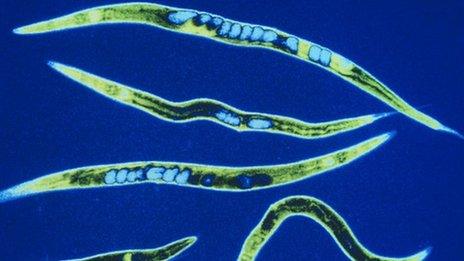Space muscles study to use tiny worms
- Published

The nematode worm species, Caenorhabditis elegans, is about 1mm in length
Thousands of baby worms will be sent into space later this year to help a study into muscle loss in older people.
Scientists at the University of Exeter in Devon say nematodes are being used because they have a similar muscle structure to humans.
Astronauts lose about 40% of muscle mass after 180 days while onboard the International Space Station (ISS).
Researchers hope the research could help people with conditions including muscular dystrophy and diabetes.

Colleen Deane is testing a drug on Sidmouth resident Nick Thompson, which could help maintain muscle strength in older men
The worms - a nematode species called Caenorhabditis elegans (C. elegans) - will blast off in a rocket from the Kennedy Space Centre, Florida, on 29 November and travel 250 miles (402km) to the ISS.
They are useful to scientists studying long-term changes in human physiology because they suffer from muscle loss under many of the same conditions that people do.
Colleen Deane, a researcher at the University of Exeter, said muscles weakened in space due to a lack of gravity.
"When they return to Earth astronauts are unable to be as mobile and they have to undergo heavy rehabilitation programmes," she said.
"Because it's a good model for human muscle, we're sending worms up to space and looking at the changes and the effects of space flight on their muscles."

You may also like:


The worm study was set up by Dr Timothy Etheridge from the University of Exeter in 2015
The worms, too small to be seen by the naked eye, will be placed in small bags of liquid food and flown to the ISS to live and produce offspring for just under a week.
They will then be frozen at -80C (-112F) by the astronauts before being returned to Earth for analysis of muscle health.
Nematode worms have been routinely taken as cargo on space missions to study and they even survived the Columbia space shuttle disaster in 2003.
Related topics
- Published27 April 2013

- Published6 July 2012

- Published30 November 2011
